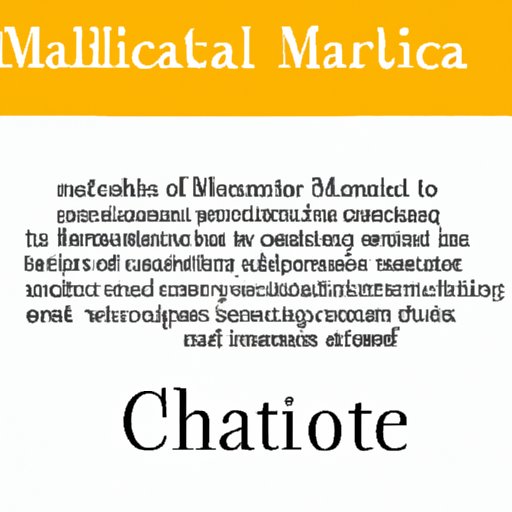Introduction
Properly citing sources is a critical part of academic writing, and MLA (Modern Language Association) citation is the most commonly used format for humanities and social science research papers. Incorrect or incomplete citations can result in accusations of plagiarism, damaged credibility, and lower grades. This article will provide a thorough guide to mastering MLA citation, including understanding its essentials, step-by-step instructions, common mistakes to avoid, and quick tips for formatting in-text citations and works cited pages.
Understanding the Essentials of MLA Citation
MLA citation is used to give credit to sources used in research papers, essays, and other academic writing. The purpose is to provide information about the source in a consistent and uniform manner, allowing readers to locate and verify the sources. The basic elements of an MLA citation include the author’s name, the title of the source, the publication date, and the publication information, such as the name of the publisher or website. Accuracy and consistency are essential to ensure that the source can be easily identified and located.
A Step-by-Step Guide to Citing Sources in MLA Format
The following is a step-by-step guide for citing different types of sources in MLA format:
Books
The basic format for citing a book in MLA style is:
Lastname, Firstname. Title of Book. Publisher, Publication Date.
For example:
Smith, John. The History of the World. Penguin Books, 1999.
If the book has multiple authors, list all of them, separated by commas, with the last author’s name preceded by “and.”
If the book has an editor instead of an author, include the editor’s name after the book title, followed by “ed.”
Articles from Journals and Magazines
The basic format for citing an article in MLA style is:
Lastname, Firstname. “Title of Article.” Name of Journal or Magazine, vol. Volume Number, no. Issue Number, Publication Date, pp. Page Numbers.
For example:
Johnson, Sarah. “The Impact of Climate Change on Wildlife.” National Geographic, vol. 235, no. 4, June 2019, pp. 22-28.
Websites
The basic format for citing a website in MLA style is:
Lastname, Firstname. “Title of Webpage.” Name of Website, Publisher, Publication or Revised Date, URL.
For example:
Smith, John. “The Best Ways to Save Money on Travel.” Travelocity, 1 Jan. 2020, https://www.travelocity.com/save-money-travel/.
If there is no author listed for the webpage, begin the citation with the title of the webpage.
Common Mistakes to Avoid When Citing in MLA Format
There are several common errors people make when citing sources in MLA format. The most frequent include incorrect formatting, missing information, and inaccurate punctuation. To avoid these mistakes, check your citations carefully and use the appropriate formatting rules. It’s also helpful to use a citation guide or software program to assist in the process.
Quick Tips for Formatting In-Text Citations and Works Cited Pages in MLA Style
There are two types of MLA citations: in-text citations and works cited entries. In-text citations are brief references within the text of your paper that indicate where you found your information. Works cited entries are detailed lists of sources that appear at the end of the paper.
In-text citations should include the author’s last name and the page number(s) where the information was found, placed in parentheses. For example, “According to Jones (42), the results of the study showed…”
Works cited entries should be listed in alphabetical order by the author’s last name or the title of the source, if there is no author. The first line of each entry should begin at the left margin and subsequent lines should be indented.
If a source doesn’t have all the necessary information, leave out the unknown information, such as the date of publication, and indicate the missing information with the abbreviation “n.d.” for “no date.”
The Importance of MLA Citation and Why It Matters
Properly citing sources is crucial for academic integrity, avoiding plagiarism, and improving credibility as a writer. Using MLA citation demonstrates your commitment to ethical and accurate research, and it allows readers to easily locate and verify your sources. By following quality citation standards, you will create a document that is professional, reputable, and respected.
Expert Advice for Mastering MLA Citation
Experts suggests that the best way to master MLA citation is to practice and gain experience. Each time you use an outside source, cite it accurately using the appropriate format. Additionally, make use of online citation generators or software such as EndNote or Mendeley to help streamline the process.
MLA Citation Made Easy: Streamlining Your Research Process
Streamlining the research process can be easily achieved by using citation management software, which eliminates the need to create your works cited list manually. In addition, keeping records of your sources as you go along is helpful, and taking time to review your works cited list and in-text citations before submitting your work will ensure accuracy and avoid costly errors.
Conclusion
Mastering MLA citation is a valuable skill for any writer. By following the step-by-step instructions in this guide, you’ll be able to create accurate and complete citations that demonstrate your research ethics and improve your credibility as a writer. Proper citation is not only good practice—it’s essential for academic integrity, avoiding plagiarism, and presenting a professional and reputable document.
